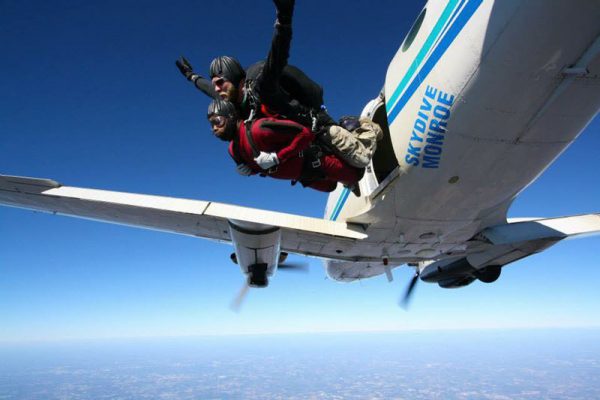Do you have to be physically fit to skydive? The answer is not as straightforward as you might imagine. Skydiving is not as passive as, say, an amusement park ride. Even tandem skydiving, when you are attached to an instructor, requires the participant to actively engage in the experience by performing certain tasks (i.e. arching the body to assist with stable freefall or lifting one’s legs to aid in a smooth slide-in landing), and thus, there are certain physical requirements to skydive.
Fitness Requirements to Skydive
Fitness is more than meets the eye. Skydiving is accessible to a wide variety of people even with certain physical limitations. This is one of the things that makes our sport so great. You needn’t be a marathon runner or Crossfit fiend to participate.
However, there are certain health shortfalls that may potentially preclude you from skydiving. This includes certain cardiovascular problems, vertigo, and spinal issues. The best way to determine if you’re in the right shape to skydive is to reach out to your primary physician. Admittedly, many doctors are not exactly savvy about the dynamics of skydiving and the forces exerted on the body throughout the experience. The best bet for an informed medical opinion is to ask to be referred to a doctor who skydives as a hobby or to reach out to an Aviation Medical Examiner (the doctors who specialize in healthcare for pilots).

Weight Restrictions and Skydiving Equipment
One of the most common inquiries we get relates to the skydiving weight requirement. The skydiving weight limit in Georgia at our facility is 225lbs for men and 170lbs for women. As we all know, weight is not necessarily directly in correlation with one’s health or overall fitness. There are plenty of people who tip the scales above 225lbs who are, for all intents and purposes, considered fit. However, we are quite firm on these skydiving weight limits at our Georgia drop zone, and there is good reason for it.
Nearly everywhere in aviation, you will find weight restrictions. Specifically, with skydiving, you will find these restrictions placed on the gear that we use. Each reserve parachute (the backup parachute used in the event of an emergency) is issued a Technical Standard Order by the Federal Aviation Administration. Simply put, this is the limit under which the equipment will function properly. Parachutes and harnesses are only made to carry a certain amount of weight, and we cannot safely exceed those limits.
Set an Intention and Make it Happen
If you want to skydive but don’t quite feel physically fit enough or you find you’re just above the skydiving weight requirement, there is still hope. Physical fitness is something we can always improve upon, within reason. Set an intention to skydive and begin making those small lifestyle changes to make it happen. After all, a journey is begun with just one step.

What drives us to reach our goals?
Motivation is typically broken down into two categories: extrinsic motivation and intrinsic motivation. Extrinsic motivation is the motivation to perform or achieve a goal in order to earn a reward or to avoid punishment. Intrinsic motivation, and a powerful motivator at that, comes from within. Intrinsic motivation is derived from a desire to perform an activity or achieve a goal of its own sake for personal rewards.
For so many, the intrinsic value of finally being able to achieve flight with a skydive is the perfect motivator to work on their physical fitness. While we start looking toward the new year as a time to make resolutions, re-vamp old goals and finally succeed, why wait? Start working toward making your skydive a reality today.
Copyright © 2025, Skydive Monroe, All Rights Reserved.
DropZone Web Design & Marketing by Beyond Marketing, LLC



